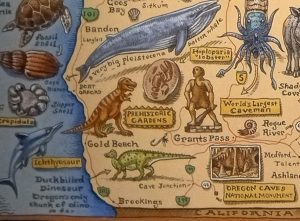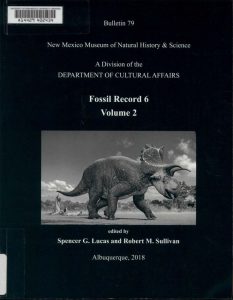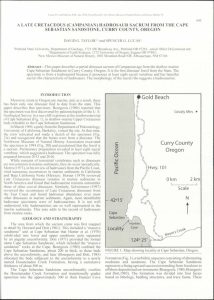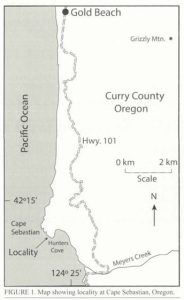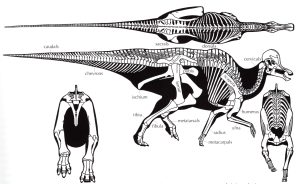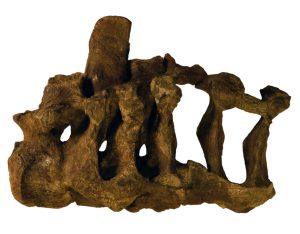Previously I wrote three articles on the findings of dinosaur fossils in the state of Oregon. You can find article #1 here, article #2 here, and article #3 here. One of my conclusions regarding these articles as of June of 2022 was that there had been only one dinosaur fossil found in Oregon so far. That fossil was the duck-billed dinosaur toe fossil discovered by Greg Retallack that he discovered in 2015 and that was formally published in 2018.
I have now come to understand my conclusion to be fundamentally incorrect. I will explain why I believe that my former conclusion was wrong, and then I will provide some information about the dinosaur fossil discovery that actually preceded the toe bone.
I have discovered the following salient information about a hadrosaur sacrum fossil found near Gold Beach, Oregon:
1. It was first reported discovered in March of 1969 by a party from the Department of Paleontology, University of California. The party made a sketch of the specimen and recognized that the bones were from a dinosaur. They did not attempt any recovery of the bones.
2. Numerous newspaper articles documented the recovery of the fossil sacrum in August 1994 by a party led by David G. Taylor. See Figure 1 for one of the articles that was published in the Oregonian newspaper
3. According to a scientific paper published in 2018 by David G. Taylor and Spencer G. Lucas, the fossil sacrum specimen was fully prepared between 2013 and 2016.
4. In the book Oregon Fossils-2nd Edition by Orr and Orr that was published in 2009 the following was quoted on page 142 along with a photo of Dave Taylor: “To date only a single fragmentary dinosaur bone has been collected in the state. Dave Taylor recovered a sacrum (the fused backbone pieces above the pelvis) of what appears to be a hadrosaur or duck-billed dinosaur. The bones were embedded in a very hard layer of the late Cretaceous Cape Sebastian Sandstone a few miles south of Gold Beach in Curry County.”
5. On Ray Troll’s artistic map of fossils in Oregon that was copyrighted in 2013 is shown the Gold Beach finding on the lower left-hand corner of the map. The toe bone from near Mitchell, Oregon is not shown because it had not yet been found in 2013. I have previously shown and discussed Troll’s fossil map in my discussion of the Hatfield Marine Science Center here. See below in Figure 2 a section of the map photo I took that reads, “Duckbilled Dinosaur Oregon’s Only Chunk of dino so far.” The caption is located on the map just off the location of Gold Beach. It clearly is a reference to the fossil recovered by Dave Taylor.
6. The sacrum finding was formally published in 2018 in Bulletin 79 of the New Mexico Museum of Natural History & Science. (Cover and abstract are shown in Figures 3 and 4.)
It is for these reasons that I think that the first dinosaur find was the hadrosaur sacrum fossil near Gold Beach, not the toe bone near Mitchell. Retallack as of April 6, 2024, in a video on the University of Oregon museum website, touts only his toe bone and makes no mention of the sacrum. From my position not directly involved in either fossil it seems that the actual sacrum finding preceded the toe bone finding by at least four decades. I also found that a search of Retallack’s published papers reveals no particular interest in dinosaur fossils by him prior to the 2015 find. The fact that he makes no mention of the sacrum indicates to me that it is important to him that he be considered as the discoverer of the first dino bone in Oregon.
On April 10, 2025, I was able to talk by telephone to Dave Taylor about the Oregon dinosaur conundrum. He told me that he thought that both he and Retallack were working on their dinosaur scientific papers at the same time in 2017-18 unbeknownst to each other. He also said he agreed with my opinion regarding what was, and still is, going on at the University of Oregon regarding the dinosaur findings in the state. He said that everyone involved in any way in Oregon paleontology was well aware of the fact that the sacrum discovery predated the toe bone. He said that he had considered making a point of the curious U of O treatment of the two findings, but in the interest of academic good will he decided against it.
I have Dave Taylor’s approval to meet with him at a later date yet to be determined at the Oregon Museum of Science and Industry to see the actual hadrosaur sacrum fossil.
Figure 1. Sacrum Recovery Documented in August 1994 Oregonian.
Figure 2. Section of Ray Troll’s 2013 Fossil Map on First Oregon Dinosaur.
Figure 3. The Cover of Bulletin 79-Inside is Round the Hadrosaur Fossil Paper.
Figure 4. Taylor & Lucas Paper First Page.
So, next I will look at the hadrosaur sacrum itself as revealed in the 2018 paper by Taylor and Lucas. Figure 5 is a map from that paper that shows the location of the sacrum south of Gold Beach on Cape Sebastian. (It was figure 1 in the paper.) This location is 260 miles southwest of where Retallack reported that he found the toe bone.
Figure 5. Sacrum Find Location.
Figure 6 is a diagram of a hadrosaur dinosaur skeleton that shows the sacrum in the middle back above the ilium bones. Notice that in the top view the bones are fused together. Figure 7 is a photo of the sacrum from Oregon.
Figure 6. Hadrosaur Skeletal Components (By Gregory Paul.)
Figure 7. Hadrosaur Sacrum from Oregon Recovered by Dave Taylor.
It is clear that the sacrum fossil is not complete nor is it in the greatest shape. But Taylor and Lucas make a strong case that it is clearly from a dinosaur. And this is the first dinosaur fossil discovered in the state of Oregon. In my opinion the Oregon dinosaur mystery can now be considered solved.
J.D. Mitchell

